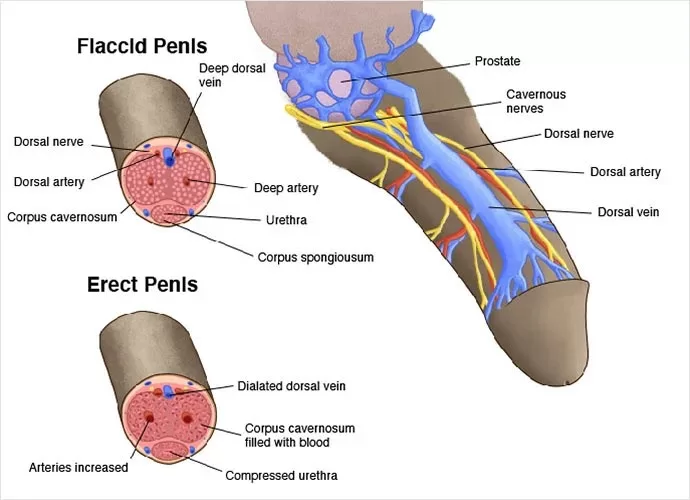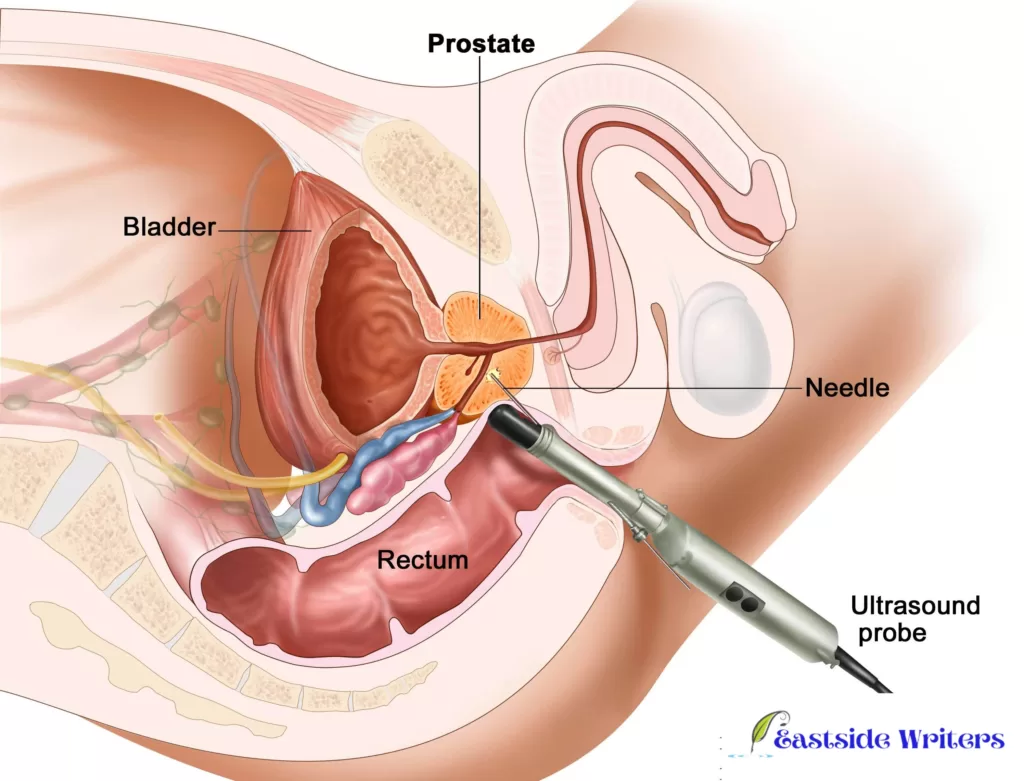Cancer is a disease characterized by the unchecked proliferation of cells, while Prostate cancer is an abnormal growth of cancer cells developed in the prostate gland. Throughout the world including America and India, prostate cancer is the most common type of cancer among men. It occurs when cells in the prostate gland grow uncontrollably, forming a tumor that can spread to other parts of the body if left untreated.
While prostate cancer can be a serious and potentially life-threatening condition, it is important to remember that there are many effective treatments available. By being proactive about their prostate health and taking steps to reduce their risk, men can maintain good health and quality of life for many years to come.
Understanding the Prostate

The penis, seminal vesicles, testicles, and prostate are all components of the male reproductive system. The prostate sits beneath the bladder and ahead of the rectum. Approximately the size of a walnut, it encloses the urethra, the tube through which urine is expelled from the bladder. Fluid from this organ is also included in sperm.
The prostate grows larger in most men as they get older. Because of this, urine output may drop and the urethra may become narrower. Benign prostatic hyperplasia is a common condition that should not be confused with prostate cancer. In addition to cancer, men can experience a variety of benign prostate changes.
How many distinct forms of prostate cancer are there?
Adenocarcinoma is the type of prostate cancer most commonly diagnosed. Cancers called adenocarcinomas begin in the cells of fluid-secreting glands like the prostate. Prostate cancer almost never develops in non-prostate cells.
The following are examples of rarer forms of prostate cancer:
- Transitional cell carcinomas.
- Small cell carcinomas.
- Sarcomas.
- Neuroendocrine tumors.
The incidence rate of prostate cancer.
In 112 countries, prostate cancer is the most common cancer diagnosis, and in 48 countries, prostate cancer is the leading cause of cancer death. It is important to note that the aging of the population and rising prosperity are both predicted to increase the prevalence of prostate cancer. In both sexes, prostate cancer is the second most common form of the disease.
The CDC reports that 13 of every 100 men who have prostates will be diagnosed with prostate cancer at some point in their lives. The vast majority will go on to lead normal lives until their deaths. Some people won’t have to get help.
In 2020, it is expected that there will be 1,414,000 new cases of prostate cancer diagnosed and 375,304 deaths caused by prostate cancer worldwide.
Causes of Prostate Cancer
The exact cause of this illness or disease is unknown at this time, according to researchers. When certain alterations take place, typically in glandular cells, its development begins. Prostatic intraepithelial neoplasia is the medical term for abnormal cell development in the prostate gland (PIN). Men over the age of 50 make up nearly half of the population with PIN.
Slow and noncancerous changes are to be expected at first. However, over time, they may develop cancerous properties. Cancer’s cell grade can be high or low. While low-grade cells are not a cause for concern, high-grade cells are more likely to grow and spread.
Possible dangers:
While the exact cause of prostate cancer remains unknown, these risk factors may increase the disease’s prevalence:

General aspects:
Prostate cancer is less common in men under the age of 45 but has an increased risk after the age of 50.
The condition is more prevalent among people of African descent than among those of European ancestry. The risk is lower among Asians and Hispanics than it is among Blacks and whites.
A higher risk of developing prostate cancer exists in people who have a family history of the disease.
Aspects of your genes:
Mutations in the BRCA1 and BRCA2 genes, which are passed down from generation to generation, may increase susceptibility. The risk of developing breast cancer is also raised by mutations in these genes. Lynch syndrome increases the risk of developing prostate cancer and other cancers in males.
The Diet:
According to reliable sources, eating a lot of fat can raise your chances of developing prostate cancer.
Other Potential Contributors:
Although more study is needed to definitively link them, the following may also affect the risk of prostate cancer:
Inflammation of the prostate is caused by obesity, smoking, red meat consumption, and exposure to chemicals like the herbicide Agent Orange. Alcohol consumption also has been linked to an increased risk of prostate cancer.
Does Prostate cancer affect transgender people?
Prostate cancer can occur in men who were born with a prostate. Prostate cancer cannot manifest in people who were born without a prostate.
Although trans women who take hormones like estrogen may be at a lower risk, they are still vulnerable. Prostate cancer screening is recommended for all men who were born with a prostate.
When does prostate cancer show up?
Symptoms are uncommon in men with prostate cancer in its early stages. As the disease develops, it may cause these problems:
Constant and urgent urination, especially during sleep.
Lackluster or intermittent urine production.
Urinary discomfort or burning (dysuria).
Inability to control urination (urinary incontinence).
Defecation incontinence (fecal incontinence).
Ejaculatory pain and inability to maintain an erection (ED).
Hematospermia, also known as blood in the urine.
Discomfort in the chest, hip, or lower back.
Should prostate issues always be traced back to cancer of the prostate?
Prostate tumors are not always cancerous. Prostate cancer symptoms can also be caused by other conditions, such as:
Eventually, nearly everyone who has a prostate will experience symptoms of benign prostatic hyperplasia (BPH) (BPH). Although this condition can cause an enlarged prostate, it does not raise the risk of cancer.
An enlarged prostate gland is most likely prostatitis if you’re younger than 50. Inflammation and swelling of the prostate gland caused by prostatitis are typically harmless. Infections caused by bacteria are a common culprit.
How is prostate Cancer dealt with or treated?
Your treatment options will be determined by a number of factors, such as your current health status, whether or not cancer has spread, and how quickly it is spreading. Different types of oncologists, such as urologists, radiation oncologists, and medical oncologists, may be involved in your care. When caught early, prostate cancer is often treatable and even cured.
Methods and Procedures Followed:
Surveillance
If your cancer progresses slowly and hasn’t spread, your doctor may opt to monitor your condition rather than treat it.
During active surveillance, patients undergo regular screenings, imaging studies, and biopsies to track the development of their cancer. If your cancer is localized to your prostate, progressing slowly, and you are experiencing no symptoms, active surveillance may be an option for you. Your doctor may decide to begin treatment if your condition worsens.
Patient vigilance: Similar to active surveillance, watchful waiting is used when a patient is too weak to undergo treatment for a terminal illness like cancer. We also conduct tests less frequently now. Most treatments aim to alleviate symptoms rather than eliminate the tumor.
Radiation treatment
Radiation therapy can be used alone or in conjunction with other therapies to treat prostate cancer. Symptoms can also be alleviated by radiation therapy.
Brachytherapy: In brachytherapy, radioactive seeds are inserted into the prostate to deliver radiation therapy internally. This method eliminates cancer cells without harming the healthy tissue around them.
In external beam radiation therapy (EBRT), powerful X-ray beams are aimed at the tumor from outside the body. The tumor can be targeted with high radiation doses using specialized forms of EBRT, such as IMRT, which spares healthy tissue.
Surgery

The prostate gland is removed during radical prostatectomy. If prostate cancer hasn’t spread, it may be cured. If your doctor thinks you would benefit from removal surgery, they can advise you on the most appropriate procedure.
The prostate gland is removed during an open radical prostatectomy through a single incision made from the patient’s belly button to the pubic bone. Robotic prostatectomy and other less invasive options have reduced the frequency with which this method is used.
Through the use of a surgical robot, your surgeon can perform a radical prostatectomy through a series of tiny incisions. They don’t actually do the work themselves, but rather control a robot system from a control panel.
Systemic treatments
If cancer has spread from the prostate gland to other parts of the body, your doctor may suggest systemic treatments. Substances used in systemic therapies target cancer cells wherever they may be located in the body.
Hormone therapy:
Testosterone stimulates the growth of cancer cells. Hormone therapy involves the use of drugs to inhibit the growth of cancer cells, which are stimulated by testosterone. The medications work by lowering or blocking testosterone’s ability to reach cancer cells. Your doctor may also suggest that you have your testicles surgically removed (orchiectomy) so that they are unable to produce testosterone. Those who prefer not to take medication can consider this surgery as an alternative.
Chemotherapy:
Chemotherapy is a treatment method that makes use of drugs to eliminate cancer cells. When cancer has spread beyond the prostate, other treatments, such as chemotherapy or hormone therapy, may be necessary.
Immunotherapy:
Immunotherapy boosts your body’s natural defenses, making them more effective against cancer. If you have advanced cancer or cancer that has returned, your doctor may suggest immunotherapy (cancer that goes away but then returns).
Specific treatment:
To stop the spread of cancer, targeted therapy destroys only the cells that have acquired the mutations that transformed them from normal cells. Treatments that target specific mutations, like those in the BRCA genes, are effective against prostate cancer.
Focused treatment;
Focal therapy is a novel method of treating prostate cancer by targeting and destroying individual tumors. If the cancer is low-risk and hasn’t spread, your doctor may recommend this treatment. There are a lot of treatments out there that haven’t been tried yet.
The cancer cells in your prostate can be killed with high-intensity sound waves by using a technique called high-intensity focused ultrasound (HIFU). The prostate tumor can be destroyed by cryotherapy, in which cold gases are used to freeze cancer cells.
By focusing intense heat on the tumor, laser ablation can eradicate prostate cancerous growth.
Medications used in photodynamic therapy render cancer cells more vulnerable to specific wavelengths of light. The cancer cells are exposed to these wavelengths of light by a medical professional, killing them.
Potential risks associated with treating prostate cancer
Some of the possible adverse effects are:
If you suffer from incontinence, you may find that you leak urine when you cough, laugh, or feel the need to urinate suddenly even if your bladder isn’t full. Without treatment, this issue typically improves within the first six to twelve months.
Damage to the erectile nerves in the penis caused by surgery, radiation, or other treatments can lead to erectile dysfunction (ED). In most cases, men are able to get their erections back within a year or two (sometimes sooner). In the meantime, medications that increase blood flow to the penis, such as sildenafil (Viagra®) or tadalafil (Cialis®), can be helpful. If the erection of the penis still remains a problem or if the penis cannot sustain the erection you may consult your physician immediately.

The ability to produce or ejaculate sperm can be negatively impacted by medical interventions, leading to infertility. Before beginning treatment, you can store your sperm in a sperm bank if you plan to start a family in the future. Sperm extraction is an option after completing treatment. Sperm is harvested from the male reproductive organ and placed into the female reproductive organ during this procedure.
If you’re feeling any discomfort as a result of your treatment, be sure to let your doctor know. They can frequently suggest helpful treatments and interventions.
In what ways can I keep prostate cancer at bay?
Prostate cancer cannot be avoided through prevention. However, you can lessen the odds by doing the following:
The prostate should be checked regularly. Discuss your risk factors with your doctor to determine how frequently you should undergo screening. Also, have your weight in check. Find out from your doctor what their criteria are for a healthy weight.
Do regular exercise. More than 20 minutes of exercise per day, or 150 minutes per week, is recommended by the Centers for Disease Control and Prevention.
Maintain a healthy diet. Good eating habits can help you live longer and feel better regardless of whether or not you have cancer. Take in plenty of whole grains, produce, and legumes in your diet. Stay away from processed and red meats.
Put down the cigarette. Stay away from cigarettes. If you smoke, you and your doctor should work together to develop a plan for quitting.
What is the prognosis for prostate cancer, and is it highly curable?
In a nutshell, if caught and treated early enough, prostate cancer can be cured. More than 90% of prostate cancer cases are detected at an early stage when the tumors are more amenable to treatment. Surgery and chemotherapy are not the only options for treatment.
Prostate cancer can be successfully treated with non-invasive radiation therapy; in the case of Pasadena CyberKnife, radiosurgery treatment typically takes less than a week, and you can typically resume your normal activities the same day you receive treatment.
If you want to know if prostate cancer can be cured, you need to know what doctors mean when they say that. Doctors consider cancer “cured” when a patient is cancer-free for a predetermined amount of time after treatment, regardless of the type of cancer. Higher rates of patients remaining cancer-free for five years or more indicate greater success in treating the disease.
Therefore, thanks to early detection guidelines and developments in treatment, such as the stereotactic body radiation therapy (SBRT) provided by Pasadena CyberKnife, prostate cancer has one of the highest curability rates of all cancer types. Five-year survival rates are close to one hundred percent when cancer is discovered in its earliest, local, or regional stages before it has spread beyond the pelvic regions.
Late-stage cancer detection is associated with a much lower chance of survival, but the good news is that only about 5% of men are diagnosed when the disease has metastasized throughout the body. One of the most treatable cancers, prostate cancer has a five-year survival rate of 90 percent or higher for men who receive treatment.
Conclusion
Prostate cancer is a serious condition that affects a significant number of men, particularly those over the age of 50. While prostate cancer can be life-threatening, early detection and treatment can greatly improve the chances of a positive outcome. There are several options available for the treatment of prostate cancer, including surgery, radiation therapy, and hormone therapy. The choice of treatment will depend on a variety of factors, including the stage and aggressiveness of cancer, as well as the individual’s overall health and preferences.
In addition to medical treatment, there are several lifestyle factors that can help reduce the risk of developing prostate cancer, including maintaining a healthy diet, engaging in regular physical activity, and avoiding smoking and excessive alcohol consumption.

It is important for men to be proactive about their prostate health by getting regular check-ups and screenings, particularly if they are over the age of 50 or have a family history of prostate cancer. By being aware of the signs and symptoms of prostate cancer and taking steps to reduce their risk, men can take control of their health and potentially prevent or detect prostate cancer at an early stage.
Disclaimer:
The author’s views are his or her own. The facts and opinions in the article have been taken from various articles and commentaries available in the online media and Eastside Writers does not take any responsibility or obligation for them.
Note: Contact our Writers at www.eastsidewriters.com for writing Blogs/Articles on any niche. We have experts in various domains from Technology to Finance and from Spirituality to Lifestyle and Entertainment.







Pingback: The Burden and Agony of Pelvic Floor Pain and Its Path to Relief - Eastside Writers